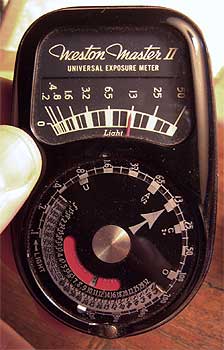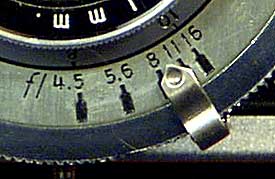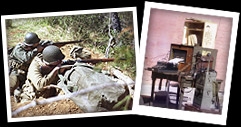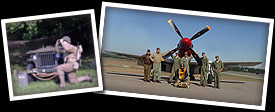Camera Basics
by Brian Mead
Kodak 35 Camera

For my explanation of the operation of WW2 era civilian cameras, I'm going to use a Kodak 35. This was a fairly common, simple cheap camera that many GIs could have afforded. Of course, there was the oft broken rule against cameras in a combat zone, but we'll not bother with that in this discussion.
The Kodak 35 is a 35mm film camera. It uses "modern" 35mm film which is available at any drugstore, camera shop, or grocery store. The film used by any period camera is very important. Some cameras use film which is unavailable, or very expensive to purchase or develop. The 35mm cameras are going to be the cheapest cameras to use, even compared with other "common" formats still in use.
 |
Light MeterThe light meter gives you an accurate reading on the light level (brightness) of the subject. On this light meter, there is a plastic prism on the back. The light goes thru the prism, and meter displays the level of light on the scale on the front of the meter. You rotate the red center dial to the film speed in the camera. (100asa, 200asa, 400asa, etc) This adjusts the dial to give the f-stop & shutter speed for that film speed. The meter is set for 200 speed film for this example. This meter is reading "13" on the light scale. To take a properly exposed picture, you simply rotate the outer ring of the dial so that the arrow points to "13". You then read the f-stop/shutter speed combinations that match up. Click HERE to see a closeup of the light meter dial. Some of the combinations are: You may be wondering why there are so many acceptable settings for the f-stop & shutter speed. Here's a couple considerations:
|
Estimating Light Level
If you don't have a light meter, you can estimate an f-stop/shutter speed. This is not as accurate, but can yield acceptable results with practice. Oftentimes, a chart will be included on the inside of the film box which tells you recommended settings.
Focus, f-stop, Shutter Speed
There are three settings which will need to be set to achieve a clear, well exposed picture.
 |
FocusOn the Kodak 35, the center of the lens rotates allowing you to focus the camera. It can be focused from about 3.5 feet to infinity. When looking down at the camera, there is a bar which extends out from the camera at the top of the lens. You can see the end of the bar at the top of the photo to the left. To focus the camera, you estimate the distance to your subject. (hmm, that looks like about 15 feet or so) You then rotate the lens until the "15" meets up with the bar at the top of the lens. Some cameras will have a viewfinder which allows you to more accurately focus the camera. |
 |
F-StopThis is the f-stop setting on the Kodak 35. The f-stop represents the size of the aperture or hole that the light travels thru. Higher numbers give you a wider depth of field whereas the lower numbers give youa narrower depth of field. |
 |
Shutter SpeedThis is the shutter speed setting for the camera. The numbers 150-25
are 100ths of a second. |
There are many places to get a correct WW2 camera. You'll want to do some
research into what cameras were in production during WW2, and their cost when
new. Then based on your impression, you can choose a camera which you could
have afforded. You can pick up cameras at garage sales, antique shops, and
off ebay. If you're interested in a Kodak camera, there's a great document
on the Kodak site to tell you the basic info on all their cameras. Click HERE
to see a chart of the Kodak cameras, their original cost, and years of production.


